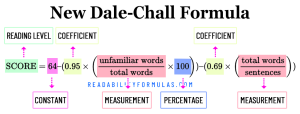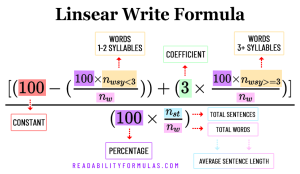Evolution of the Dale-Chall Word List
- In his doctoral dissertation, Edgar Dale focused on understanding children’s grasp of business terms. He curated a list of 2,276 business words and conducted a test on 200 significant terms.
- Dale and his colleagues compared the vocabulary of 1st-grade students with E. L. Thorndike’s list of frequently used words.
- Irving Lorge adapted Dale’s 769-word list and incorporated sentence length as a factor in readability.
- Edward W. Dolch expanded the Dale list to 1,000 words after interviewing samples of children in the first grade.
- Clarence Stone made modifications to maintain a 1,000-word list.
- George Spache used Stone’s list, made some additions and deletions, and ended up with a list of 1,041 words.
Here’s how Dale and Chall decided which words to include in the Dale-Chall Word List:
- Frequency in Texts: Dale and Chall analyzed a wide range of texts, such as books, newspapers, and magazines, to determine the frequency of word usage. For the original formula, they focused on texts commonly read by fourth-grade students in the United States, as this was their target audience at the time.
- Survey of Word Familiarity: They conducted surveys to assess the familiarity of words to fourth-grade students. They asked children to identify and define words to gauge their level of understanding and familiarity.
- Higher Reading Difficulty: Chall specifically included words that challenged students and individuals with limited reading abilities. These words were not part of the basic vocabulary for that age group, and their presence in a text could indicate a higher reading difficulty.
- Consistency in Difficulty: The selection process ensured words on the list were consistently difficult for the target audience. Selected words were less likely to vary significantly in difficulty perception among readers.
- More Challenging Words: Dale concluded that while the initial 769-word list was suitable for early reading levels, it wasn’t as effective for upper grades. As a result, a new 3,000-word list was developed, which is more comprehensive and adaptable for different reading levels.
Inflected Familiar Words: The word list does not include all inflected forms of familiar words. Any word on the word list with these variations are considered familiar words: -‘s, –s, –r, –d, –es, –ies, –ed, –ied, –ing, –er, –est, –ier, -iest.
For example:
| Dale-Chall Familiar Word |
Inflection |
New Familiar Word |
| act |
-ing |
acting |
| tight |
-er |
tighter |
| bush |
-es |
bushes |
| orange |
-s |
oranges |
| boy |
-‘s |
boy’s |
| worry |
-ies |
worries |
| package |
-d |
packaged |
| spill |
-ed |
spilled |
| spy |
-ied |
spied |
| dance |
-r |
dancer |
| great |
-er |
greater |
| brave |
-est |
bravest |
| scary |
-ier |
scarier |
| easy |
-iest |
easiest |
etc., etc., etc.
Inflected Familiar Words → Difficult Words: Words on the list with the following inflections are counted as difficult or unfamiliar: –tion, –ation, -ment, –ly, –y.
For example:
| Dale-Chall Familiar Word |
Inflection |
New Unfamiliar Word |
| complete |
-tion |
completion |
| continue |
-ation |
continuation |
| judge |
-ment |
judgement |
| normal |
-ly |
normally |
| noise |
-y |
noisy |
etc., etc., etc.
The primary goal of the word list is to help educators and researchers evaluate the difficulty of written material by identifying words that might challenge readers.
The Dale-Chall Formula is often used with other readability formulas, such as the Flesch-Kincaid Grade Level or the Gunning Fog Index, to provide a comprehensive analysis of a text’s readability.






